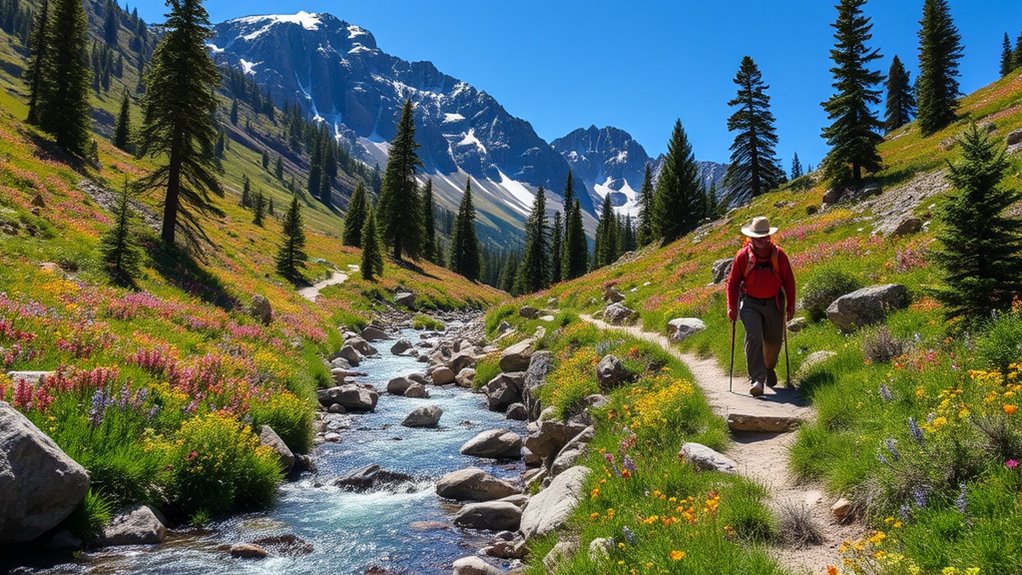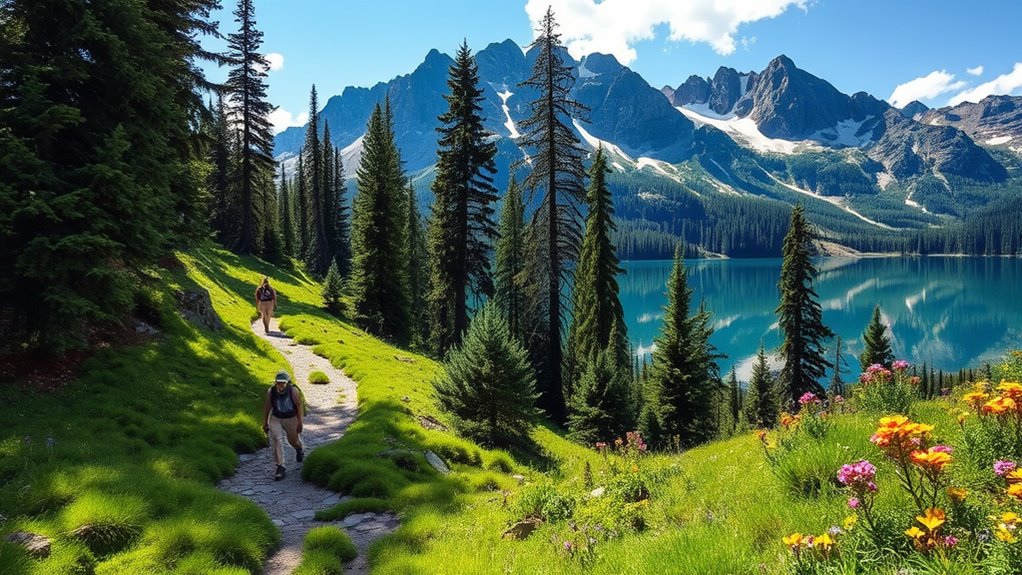When you hike in Rocky Mountain National Park, practicing low-impact techniques is essential. Stick to designated trails to protect fragile habitats and preserve the park’s stunning beauty. Always pack out any trash you find and avoid shortcuts that damage vegetation. By being mindful of your impact, you help maintain this natural wonder for future visitors. Want to discover more tips on responsible hiking and connecting with nature? Keep exploring!
Key Takeaways
- Stick to established trails to minimize damage to fragile ecosystems and preserve the park’s natural beauty for future visitors.
- Carry out all trash and litter to keep the environment clean and maintain the park’s integrity.
- Observe wildlife from a distance using zoom lenses to avoid disturbing their natural behaviors and habitats.
- Stay on designated paths when observing wildflowers to prevent harm to delicate plant species and promote conservation awareness.
- Practice patience and respect during your hike, allowing for a deeper connection with the environment and its ecosystems.

Have you ever wondered what it feels like to hike amidst breathtaking mountain vistas? As you step onto the trails of Rocky Mountain National Park, the air is crisp, and the scent of pine fills your lungs. You can’t help but feel a sense of adventure and anticipation. The rugged beauty of towering peaks and shimmering lakes beckons you forward, inviting you to explore. But while you’re soaking in the stunning scenery, it’s vital to practice low-impact hiking to preserve this incredible environment.
One of the joys of hiking is connecting with nature, and that includes learning about the diverse flora and fauna around you. As you meander along the trails, take the time to engage in wildflower identification. You’ll discover vibrant blooms like columbines and Indian paintbrush, each adding a splash of color to the landscape. By identifying these plants and understanding their role in the ecosystem, you deepen your connection to the park. Remember to tread lightly as you admire these wildflowers; staying on designated paths helps protect their fragile habitats.
Engage with nature by identifying vibrant wildflowers like columbines and Indian paintbrush while preserving their fragile habitats.
Wildlife photography offers another fantastic way to enrich your hiking experience. You might spot elk grazing in meadows or a curious fox peering through the trees. With your camera in hand, you can capture these moments without disturbing the animals. Remember, though, to keep a respectful distance and use a zoom lens, ensuring you don’t intrude on their space. Patience is key; sometimes you’ll have to wait quietly to get that perfect shot.
As you hike, it’s essential to leave no trace. Pack out what you pack in, and if you see litter, pick it up. This small act makes a big difference in preserving the natural beauty of the park for future visitors. You should also avoid shortcuts that could damage vegetation. Instead, stick to established trails to help maintain the integrity of the landscape.
Every step you take in Rocky Mountain National Park can be both a personal journey and a commitment to conservation. By practicing low-impact hiking, embracing wildflower identification, and indulging in wildlife photography, you’re not just enjoying nature; you’re becoming a steward of it. Additionally, understanding color accuracy can enhance your wildlife photography, ensuring you capture the beauty of nature as it truly is. So lace up your boots and prepare for an unforgettable adventure that respects and honors the wild beauty around you.
Frequently Asked Questions
What Gear Is Essential for Low-Impact Hiking?
For low-impact hiking, essential gear includes eco-friendly footwear, a durable backpack, and a reusable water bottle. You’ll want to pack lightweight clothing made from sustainable materials and carry a first aid kit for safety. Don’t forget a trash bag to practice Leave No Trace principles—always pack out what you bring in. Binoculars for wildlife observation and a map or GPS device can enhance your experience while keeping the environment protected.
Are There Specific Trails Recommended for Beginners?
Yes, there are several trails perfect for beginners. You’ll find the Bear Lake Trail and the Sprague Lake Trail to be easy and scenic. To guarantee trail safety, always check weather conditions and stay on marked paths. Remember to pack water and snacks! As you explore, take note of beginner tips like pacing yourself and enjoying the scenery. You’ll uncover the beauty of nature while building confidence for future hikes!
What Wildlife Should I Be Aware of While Hiking?
While hiking, you should be aware of wildlife safety to guarantee both your safety and that of the animals. Keep an eye out for bears, moose, and elk, as they can be present on trails. When you spot wildlife, maintain a safe distance for observation—never approach or feed them. Carry bear spray and know how to use it, just in case. Always respect their space, and your hike will be much more enjoyable.
How Can I Minimize My Environmental Footprint?
You can minimize your environmental footprint by practicing Leave No Trace principles. Start by sticking to established trails to avoid damaging delicate ecosystems. Always clean up after yourself—pack out what you pack in. Be mindful of wildlife; observe from a distance, and don’t feed them. Respect fellow hikers with good trail etiquette; keep noise down and yield the trail. It’s simple actions like these that help preserve nature for future generations.
Are There Any Guided Low-Impact Hikes Available?
Yes, there are guided low-impact hikes available that emphasize trail etiquette and wilderness preservation. These tours often teach you how to tread lightly, respect wildlife, and leave no trace. By joining a guided hike, you’ll not only enhance your experience but also learn valuable skills to minimize your environmental footprint. Look for local organizations that specialize in eco-friendly tours to guarantee you’re making a positive impact while enjoying the great outdoors.
Conclusion
So, if you’re looking to embrace nature without the risk of turning into a sweaty, gasping mess, low-impact hiking in Rocky Mountain National Park is your ticket. You’ll get to experience breathtaking views while barely breaking a sweat—who knew nature could be so accommodating? Just remember, the only thing heavier than your backpack should be the guilt you feel for not tackling that steep trail. After all, isn’t the essence of adventure really about comfort?










